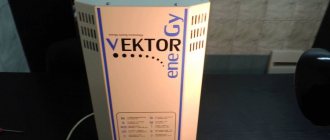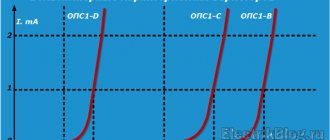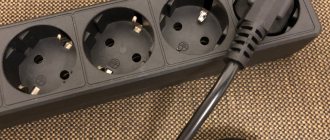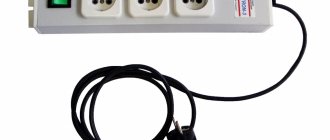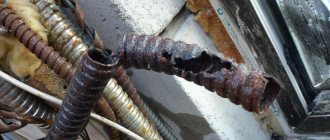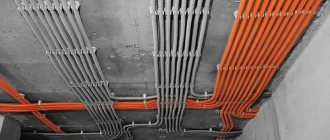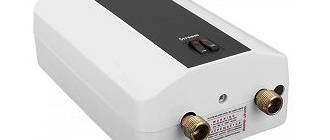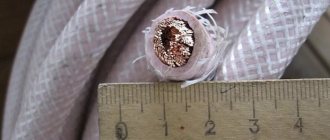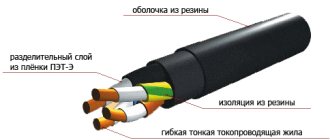Reasons why wiring gets hot
There are a number of main reasons why wires can heat up during operation:
- First of all, this is an insufficient cable cross-section. Due to the connection of much more powerful electricity consumers, the wiring will heat up;
- Secondly, this is incorrect installation of electrical wiring. For example, different cross-sections of cables or their excessively long length;
- Poor contact at the connection points or presence of twists. If the wiring is old, then there may be twists in the wall that will cause the wires to heat up. Not only are the twists hidden in the wall, but they are also prohibited according to the PUE;
- The quality of the wires itself leaves much to be desired.
Of course, if you have no experience in repairing and replacing electrical wiring, then it would be best to invite an experienced electrician to carry out the work. If you have at least some knowledge of electricity, then you can try to fix the problem yourself, without involving specialists.
So, what to do if the electrical wiring in your house gets hot?
How to properly connect aluminum wires to each other so as not to heat up
In modern apartments, electrical wiring is mainly made of copper wire. In older houses it is made of aluminum. It is not always possible to replace the previous power supply system, so when connecting sockets and lamps, you often have to connect aluminum wires to each other.
Faulty plug
There is no point in delaying repairs - the socket may spark and an unpleasant burning smell will appear. In addition to equipment failure, it is simply dangerous, for example due to the risk of fire or electric shock. It is necessary to limit the use of sockets and plugs, or better yet, stop.
If smoke or other serious signs appear, turn off the electricity. Usually the switch is located in the meter on the distribution panel. You need to hire a specialist or fix it yourself. Work is carried out after a power outage.
If the plug breaks, you can replace it or try to repair it.
Useful tips
When performing repair work on an electrical circuit, it is important to follow a few tips. Let's highlight the main ones:
Let's highlight the main ones:
- Always check the voltage level before carrying out repairs.
- If possible, call a specialist for electrical repairs.
- Install high quality machines. This requirement also applies to wires, sockets and switches.
- For safety, use cotton tape (it provides better insulation).
- The appearance of visual damage or thinning of the metal indicates the need to replace the socket.
Please note that electricity is deadly and should not be trifled with. If any problems arise with the outlet, junction box or input panel, it is better to fix the problem immediately.
Delaying repairs often leads to aggravation of the situation, damage to household appliances and even a fire.
Additionally, working on an electrical circuit without the proper knowledge may result in exposure to voltage, serious internal injury, or death.
How to reduce the temperature of the adapter?
Now you know why the laptop power supply gets very hot. It remains to understand how to rid the laptop of this shortcoming. You can try the following methods:
- Place the power supply in an area where it can cool naturally. As noted above, the adapter should not be covered with a blanket or any cloth. It is also contraindicated for him to lie on the carpet and be exposed to direct sunlight.
- Try not to overload the laptop when charging. Wait until the battery charges before launching heavy games or resource-intensive programs.
If neither natural cooling nor temporary abandonment of games reduces the temperature of the power supply, then you will have to buy new equipment with more power. But to prevent the laptop from burning out, you need to choose the right power supply, taking into account the voltage. Examine the markings on the laptop case. The charger parameters should be indicated there: for example, 19V-2.4A.
Then look at the current and voltage on the old power supply, which gets very hot. The voltage on it should be the same, but the current strength may be a little higher.
To get rid of overheating, you should buy an adapter with the same voltage (19V) and higher current - for example, 4.7A instead of 2.7A. In this case, the power supply will maintain a low temperature when charging, because the load on the nodes will decrease.
The main reasons for heating cables and wires
To understand the reason for the heating of electrical wiring, you need to remember the basics of electrical engineering. Electric current is the ordered movement of free electrons, in the path of which other atoms of a substance appear. A certain number of such atoms is called electrical resistance. If the resistance is too high, the temperature of the material increases.
An example of securely tightened wires
This principle is successfully applied, for example, in water heaters. In other household appliances or the electrical network, it is necessary, on the contrary, to reduce the heating of the conductors - to bring it to the nominal level.
The main reasons for heating cables and wires:
- The main reason why the wire heats up is the choice of its wrong cross-section. When choosing a small cross-section of wires, which haunts almost all would-be electricians, and a constant current strength, a rapid increase in the temperature of the cable occurs. The same principle applies to water pipes - the larger the diameter, the greater the water pressure.
- Overheating of the line occurs due to improper installation. For example, a minor short circuit that does not respond to an overrated circuit breaker. The machine does not open the line - the cable continues to heat up, and after a while it burns out.
- Poor quality connection or oxidation of contacts. Aluminum wires oxidize very quickly, the connections of which should be checked more often than copper wires. In order not to worry about the quality of twisting, it is better to use special terminal blocks or carefully solder the cables.
- Using a low quality cable or wire. Now the electrical equipment market is rapidly filling with products from Korea and China, the quality of which leaves much to be desired. Such a cable, even if installed correctly, can itself cause heating and fire.
How to connect aluminum wires
There are different methods that are used depending on the situation, taking into account the positive and negative qualities of each of them.
Twist
This is a simple way to connect wires, but if the twist is done incorrectly, it will not be very reliable.
The procedure is as follows:
The technology for such a connection is simple, but in order to get good contact, the work is performed only with pliers, because You won't be able to twist the wires tightly by hand.
Welding
This method allows you to create a single whole at the point of contact, so there is practically no transition resistance there, and the pressing force is reduced.
There are also some disadvantages:
Removal of oxides is carried out mechanically, but this work requires a lot of physical effort and is ineffective, because they form again almost immediately. The use of special fluxes helps to destroy the film, but it is difficult to select them at home.
You won’t be able to weld aluminum yourself without proper training. Here it is important to accurately select the operating voltage (within 20 V) and the time of exposure to the metal (1-2 seconds).
Spike
This is a labor-intensive and time-consuming process. It is practically not used in power networks, and copper wiring is now more often installed in houses and apartments.
When performing soldering, problems are also associated with the presence of an oxide film. In addition, there is no way to control the heating of the wire, and with prolonged exposure to high temperatures, aluminum changes its characteristics.
Removal of oxides is carried out with sandpaper or other abrasive materials. The oxide film quickly forms again; it is impossible to completely remove it, but it is possible to reduce the thickness of the layer.
The cores are connected to each other, then they are touched with a heated tip of a soldering iron with solder and flux. The latter destroys the oxide film well, and to make it perform its task even better, solder is scraped along the wires. If the work is done without flux, then rub the solder at the contact point more intensively.
Using Terminal Terminals
The fastest way to connect aluminum conductors is with contact clamps. They have a simple design: screw - washer - base - stop - current-carrying conductor.
Using contact clamps is simple: strip the ends of both wires to a distance of 12 mm, insert them into the holes of the clamp and securely fix them. This method is used when connecting single and multi-core wires.
The contact is stronger than twisting; the connection point does not heat up, so the likelihood of short circuits and fires is minimal.
Screw connection
If done correctly, this simple method will provide a fairly reliable connection. Due to the fact that Al has a large coefficient of linear expansion, the contact weakens over time. To prevent this from happening, periodically tighten the screw or install special washers. To increase the contact area, the cores are wound around the screw. Often, electricians flatten the ring made at the end of the wire to increase the contact area.
The connection order is as follows:
The resulting connection is clamped until the spring washer is aligned.
When using a screw connection or terminal blocks, you must adhere to the recommended values of pressure on the cable, otherwise the aluminum will quickly “leak”:
Spring connection (PPE caps)
In this case, special plastic elements are used, inside of which there are metal plates. After putting the PPE caps on the twisted spring, the cores are clamped and reliable contact is formed. This removes the oxide layer, which further improves the connection. The plastic case protects the contact point well from damage and at the same time provides electrical insulation.
For a quality connection, you need to choose the right size of caps so that they are screwed onto the wires with force.
Crimping - crimping method using sleeves
The crimping method involves the use of crimpers (crimping pliers) and special sleeves. This way you can connect aluminum conductors of different cross-sections and at the same time obtain reliable, durable contact. Using pliers and other improvised means instead of a special tool is unacceptable.
The sleeves differ in diameter and material from which they are made. Only brass or aluminum elements are suitable for connecting aluminum conductors. Their diameter must correspond to the cross-section of the conductor. If the indicator is less, then the cross-section will have to be reduced, and if it is more, then the contact area will decrease. All this will lead to its overheating.
If it is necessary to connect cores of different sections or more than 2 conductors, choose sleeves with corresponding hole diameters. You can't cut these elements in half trying to save money. The manufacturer has calculated their length; when connecting the wires, 2 opposite crimps are required, otherwise the contact will be unreliable.
Subsequently, the junction will begin to heat up with corresponding consequences.
Other options
There are several other ways to help make a quality connection:
Socket
The cause of heating may be a weak socket designed to connect a load with less power. Thus, modern electric kettles, heaters, and boilers require a 16 Ampere socket or connection directly to the panel via a circuit breaker (if the power consumption is higher than 3.5 kW). A standard 10-amp outlet, when connected to such a device, will heat up and in a short time may melt or even catch fire. For safe and uninterrupted operation of electrical equipment, the socket must be replaced.
You can also encounter a mismatch between the electrical plug and the socket - even a small difference in the distance between the pins of the plug and the holes in the socket leads to weak contact. This happens with different manufacturers or if the appliance (or outlet) is an outdated model. Heating occurs, with all its dangerous consequences. In this case, you will need to connect the device to another outlet, use an adapter, or replace the plug or socket.
If the problem is not in the plug, then it is possible
The outlet is overloaded.
Let's look at what's plugged into the outlet.
A common situation is when, due to a lack of sockets, tees or extension cords are inserted into it to connect something else needed. But the possibilities of the outlet are not limitless! On each socket the manufacturer indicates its rating, for example: “10A 220V”. This means that this device is designed for continuous operation at a current not exceeding 10 amperes and a voltage of 220 volts.
To find out how much power can be obtained from this device without DESTROYING it, we multiply 10A with 220V, we get 2200 watts or 2.2 kilowatts. Now let’s count how many of us are connected at the same time? Every modern electrical appliance has its power marked on it, which gives us the opportunity to determine whether our socket will withstand this device! If the power of all the switched on devices exceeds the capacity of the outlet, is it surprising that it heats up?
What is the way out of this situation? Additional sockets on the wall will not appear on their own, and if they do, it will not be soon! All you have to do is make sure that the devices connected to this outlet are not turned on at the same time! For example: while turning on a modern powerful kettle, we turn off the two-kilowatt heater; in two minutes of operation of the kettle, the kitchen will not cool down without the heater working!
Now let's look at the options when the outlet heats up and sparks from any load.
Here you can’t do without disassembling the outlet itself. First of all, WE TURN OFF the ELECTRICITY supplied to our outlet, and if you are not sure that you have turned off what you need, we completely cut off the power to the apartment!
Look in your electrical panel to see what you can do to turn it off, the options may be different: before your meter, and sometimes after it, there may be a bag - a black, can-like thing with a handle that can be rotated clockwise DO NOT TOUCH - DANGEROUS! (many cases when they died of “old age” when trying to switch off with serious consequences); modern white flat machines or old, Soviet-era black flat machines; push-button automatic fuses, screwed into special sockets along a thread, or even ancient white ceramic fuses, popularly called plugs. If the electrical panel is located on the staircase, you must make sure that these devices belong specifically to your apartment, and not to the neighboring one! If you couldn’t figure out how to turn off the voltage supplied to your apartment, abandon your idea of doing the repairs yourself and call an electrician! So: we turned off everything that was possible, unscrewed it, now we check the presence of voltage in the apartment.
We take a table lamp or a vacuum cleaner and check all the sockets. If it is dark or quiet, we proceed to disassemble the socket. In principle, there are special devices for such purposes, for example: an indicator screwdriver, which is sold in any tool store. However, the article can be read by a person very far from electricity and, for him, the presence of such a voltage indicator in the house is equivalent to the presence of a wrench in a handbag! Although it wouldn’t hurt to have such a device at home, we still live among “electricity!” Remove the cover from the socket, loosen the screws of the tabs that hold the socket in the socket if it is built into the wall, and carefully remove the inner part with the wires for inspection.
What if the neutral wire gets hot?
It is a rare case when the neutral wire in the electrical panel begins to heat up. For example, when recently laying a resistive cable for floor heating in an apartment. You should know that there is no life-threatening potential on the neutral conductor, and its temperature should be within room temperature, but not higher.
What could cause this heating?
- With uneven distribution of currents. This means that at the working zero the current strength exceeds the current that passes through the phases. Self-regulating cables, which are used to heat pipes, lead to this result due to their power. In this case, the zero can not only overheat, but also burn out.
- Poor contact of the neutral wire with the neutral bus. Accompanied by an unpleasant crackling sound and sparking. It is enough to tighten the contact or check the nearest place of twisting and the problem will be eliminated.
- . These are: induction furnaces, pulse consumers, heating cables, LED-based lighting sources, etc.
Consequences of poor-quality neutral wire contact
Overheating of the neutral conductor - why is it dangerous?
You don’t need to be a specialist to understand the fact that excessive overheating of the neutral conductor can subsequently lead to its burnout, and as a result, cause emergency situations.
So, for example, if in apartment buildings a three-phase power supply network is used (zero is common, and the phases are distributed alternately between apartments), then burning out the neutral conductor will inevitably cause phase imbalance, with the possibility of increasing phase voltages to linear values (380V). Naturally, without additional protection in the form of a voltage relay, household appliances with such power supply parameters will certainly fail.
When using a single-phase supply voltage, if the neutral conductor breaks, a potential will remain on its conductors (through switched-on consumers), which is dangerous to humans.
What does heating the wiring cause?
The mode of operation of the electrical circuit in which the wiring is heated CANNOT be called operational. This is a situation close to emergency and here's why.
Perceptible heating of wires (cables) means that the temperature of the current-carrying core increases, and the core begins to heat the insulation and sheath of the cable.
The core insulation material and cable sheath have very specific temperature characteristics, exceeding which leads to their destruction (melting). As a result, the insulation ceases to fulfill its main task, insulating the current-carrying conductors. This results in a short circuit and the entire wiring line needs to be replaced.
Conclusion
In residential premises, the main reason why wiring heats up is that the permissible load on a given group of electrical wiring or the entire room as a whole is exceeded.
In a normal situation, with such an excess of the permissible power, the circuit breaker or protection device should operate. But they also fail, or, even worse, they are deliberately overpriced, for example, they put a “bug” instead of a cork.
Related articles: Professional maintenance of cash register equipment
All this leads to heating of the wiring, which sooner or later will end, at a minimum, in failure of the wiring or, at maximum, in a fire.
Important! If you begin to constantly smell the smell of heated plastic, it is difficult not to notice it, it means that your wiring is heating up and it’s time to take a closer look at it.
©Ehto.ru
More articles
Similar
Solutions to the problem
If you notice a heating cable, then you need to know how to solve this problem. There are several popular ways to determine the problem and fix it.
Appliances
Household appliances are the main cause of overheating of the electrical network. Excessive heating of conductors occurs due to the high power of the consumer and the cable not designed for such power. But if this is not the reason, then a simple sequence will help you quickly find and fix the problem.
- Check whether the cable is equally heated along its entire length, or whether a high temperature is observed in one place. A common problem is poor electrical contact between the plug and the cable leading to the household appliance.
How to fix:
- It is necessary to unscrew the bolts securing the fork body and remove the top cover.
- Loosen the wire fastening contacts and remove the wires.
- Clean the wires and contact points - remove all obstacles to the passage of electric current. Then put the wires in their place and carefully tighten the bolts.
- The final stage is assembling the cover.
- Poor cable contact at the input of the household appliance. If the plug is intact, the quality of the contacts is at the proper level, and the wire is heating up on the other side, then you should check the distribution box (or, as it is called, the terminal box) of the household appliance.
How to fix:
- Unscrew the 4 bolts securing the upper cover of the terminal box and remove the cover itself. Below it there is a terminal block in which direct contact is made between the input wire and the wire of the household appliance.
- The block should be unscrewed, the wires should be taken out and stripped, as well as the places where the block is attached. For cleaning, it is convenient to use a small needle file or fine-grained sandpaper.
- After stripping, install the cables into the terminal block, tighten with bolts and replace the cover.
- If the cable heats up along its entire length, and the socket is designed for the permissible current of the household appliance, then there is only one reason - the poor quality of the cable. This conductor should be replaced.
Wiring
Excessive heating of wires in home electrical wiring is accompanied by the smell of burnt insulation and leads to improper operation of household appliances. In some cases, electrical appliances may even fail.
Fault detection sequence:
- The main problem may be the connection location of the power cables in the apartment panel. Usually the input cable is attached to a copper bus, from which the wires will go further into the apartment. A loose contact on the bus leads to gradual heating of the cable, and sparking is also possible. It is enough to strip the wire and tighten the contacts a little.
Important! Stranded copper wires must first be crimped with a sleeve, after which the tip is secured to the busbar using a bolted connection.
- Another reason for an increase in conductor temperature is a weak contact on the circuit breaker or its malfunction. The high rating of the machine leads to gradual heating of the cables, melting of the insulation and its fire. It is enough to turn on several powerful household appliances, for example, a washing machine and a boiler, while the machine is not working, and the result will not take long to arrive.
Poor contact between conductor and circuit breaker - The junction box is one of the most unsafe places in electrical installations. One under-tightened twist leads to burnt insulation and a possible short circuit. Therefore, it is better to make all connections in distribution boxes using copper terminal blocks.
How to solve the problem with heating cables?
Heating of the wiring strands during operation is normal. One way or another, when current passes, the wires will heat up. However, if their heating is too strong, this can lead to melting of the insulation.
How to prevent electrical wiring from overheating?
Therefore, first of all, you need to inspect where exactly the strong heating of the wires occurs. If it is along the entire length, then the cable cross-section is insufficient and the cable should be replaced.
If the wires heat up only at the beginning, for example from the plug that connects the washing machine or water heater, this will indicate poor contact in the socket. You should disassemble the socket and improve contact with the plug (by bending the metal contacts inside).
If the wiring is very hot at the connection points, junction boxes and panels, special attention should be paid to the connection contacts. It is not allowed to connect copper and aluminum wires by twisting. They need to be connected only through sleeves or special terminals.
Well, one last thing. When the wires become very hot, you should think about their quality. You can often find low-quality cables whose cross-section does not correspond to reality. It is precisely because the wire has a reduced diameter that it overheats.
The same core with a cross-section of 2.5 mm does not actually have one, and the average person, without knowing this, loads the wire, which leads to its overheating with a possible fire of the insulation in the future. You should not buy wires of questionable quality, and from an unknown manufacturer.
Fourth and fifth reasons. Contacts
These two reasons are the most common.
Check whether the screws marked with number 1 are tightly clamped. By the way, the contact will be better if the connected wire is placed under a ring-shaped screw (as in the photo).
Pay attention to how compressed the contacts, indicated by number 2, are. If the contacts of your socket do not include a spring (3), the “cheeks” of the contacts (2) may not tightly clamp the contacts of the plug
As a temporary measure, you can press these same cheeks together. But soon, they will unclench again and... “our song is good, start over.”
Therefore, take the time and resources to replace the socket with one with springs.
Why do conductors heat up differently?
Indeed, conductors made of different materials or at different voltages heat up differently. To explain this feature, we will use analogies. Let's try to imagine a pipe with water instead of a conductor with current. Then the voltage is the water pressure, and the current value is the thickness of its jet. The role of conductor resistance will be played by a certain porous substance that fills the pipe.
What happens when current passes through a conductor and what is needed for this? In our case, we need to ensure that a certain amount of water is pushed through the pipe. To do this, it is necessary to create a certain pressure (apply voltage to the conductor). The amount of water (current magnitude) that will pass through the pipe depends on three factors: the permeability of the pipe (conductor resistance), its diameter (conductor cross-section) and the applied pressure (voltage).
Returning to the classic conductor, we can draw the following conclusions:
- As long as the voltage is low, conductors made of different materials will cope equally well with the transmission of current.
- As the voltage increases, conductors with greater resistance will begin to heat up. An ordinary incandescent lamp works on this principle. It uses a tungsten filament as a conductor. This material has high resistance, so when an electric current passes, it heats up to a glowing temperature.
- With the same voltage and material of manufacture, conductors with a smaller cross-section will heat up more.
Why does the fork smoke and the carrier get hot? Temperature marks on the socket
| NetNotebook.Net/pda international, in Russian |
| library of articles, stories, essays, articles answering questions |
Question:
the plug gets hot
Quality of electrical appliances. What does China have to do with it?
Overheating is a serious and dangerous electrical fault.
Electrical theory explains everything
Overheating of the electrical plug (plug, connector) occurs most often, since it is an electrical and mechanical element that is subject to wear, so we’ll start with it.
A plug is part of a plug connection, a connector. power plug and socket
According to Ohm's law, on a conductor having a resistance R, when a current I passes, power P is released. This same power P is released in the form of heat - the temperature of the conductor rises until the heat flow from a heated object (an electric plug, or rather a metal pin , plates) will not become equal to P. The plug pin in the socket is poorly cooled; it is surrounded on all sides by the socket body and the plug body, usually made of plastic.
P = I**2 * R, or P = I2xR
The power output is equal to the current squared times the resistance.
For example, an electric heater with a power of 2.2 kW (2200 watts) consumes about 10 amperes of current at a network voltage of 220/230 volts.
One square meter of surface at temperatures acceptable for plastic, up to approximately +70 Celsius (the housings of plugs and sockets are made of supposedly non-flammable electrical plastic) can dissipate about 0.5 kilowatts of heat. This is a very approximate figure, as it depends on the shape, airflow-convection, color(!) in the infrared range, thermal properties of the surface, etc.
The usual plug pin for powerful electrical appliances with a current of up to 16 amperes is of the “German type”, “Euro” Schuko has a diameter of 4.8 mm and a “protruding” length of 20 mm, plus about 5-7 mm are located inside the body of the electric plug (usually Euro plugs are non-removable mono-casting made of elastic plastic). It turns out that the area of the plug pin is 0.00060288 square meters, and such an area without overheating can dissipate 0.00030144 kilowatts of heat.
Only 0.3 watts! If a real copper wire of normal cross-section is soldered to the pin, then another 5-10 watts of heat will be dissipated through it. What if the cord wire is “Chinese-progressive-energy-saving”? Oh, this is completely unpredictable, regardless of whether the electric heater is labeled Made in Germany
or
Made in EU
, or honestly
Made in PRC
As Ivanov, then still an associate professor, said: there is a lot written on fences - read About the country of production of goods and barcodes
Let’s say you’re lucky with the plug and socket, and they are capable of not burning out, not melting, not swelling, not smoking, dissipating 1 watt of power. From the above formula it follows that the maximum possible resistance is
R = P/I2 = 1 watt/(10 amps)2 = 0.01 Ohm.
0.01 Ohm is a very small resistance, without using a special measuring circuit, you cannot measure it with a regular multimeter!
The fork didn't get hot before, but now it does.
If earlier this
the plug was plugged into
this
socket, and everything was fine, then:
A)
The most likely location and cause of increased resistance of the electrical circuit,
somewhere near the plug,
is the point of contact between the pin of the plug (the “male” power connector) and the contact plate of the socket (the “female” connector). There is always a possibility of the contact burning and increasing the resistance of the plug-socket pair at the point of contact, and the contamination on the plug is often barely noticeable; the contamination collects on the contact plate of the socket. What to do if the fork starts to heat up?
1. Clean the pins of the plug, not with a file, and without causing wounds to the metal surface - with thick paper or a piece of wood moistened with pure alcohol, at worst, with pure vodka without additives of dyes and flavors, “honey” and saccharin, and in no case - “with vitamin C” and grind the pins firmly and evenly.
2. De-energize the socket (check with a phase indicator, electric miracles can happen, especially in cold weather!), remove the cover and use the same tool in alcohol, only folded in the shape of a pin, to clean and polish the contact plates.
3. Check whether the contact plates of the socket tightly grip the pins of the plug. If the contact between the pin and the contact plate has play, you can try to tighten the spring or contact plates. If the pressure is poor, not only carbon deposits can occur, but also sparking with a bang.
or
b)
Or it’s easier to throw out the socket and install a new one, wiping and checking the tightness of contact with this plug. But a new electrical outlet may turn out to be worse than the old one, because... The global impudence of customers, sellers, manufacturers and inspection bodies is growing every year. The clearest example is household light bulbs. “The warranty has expired. And sure enough, it broke.”
The designation of mother-father connectors in English is a completely official electrical-and-not-only term: male-female
It seems that the fork was not heating up before, but now it is starting to heat up -2
Cleaned the contacts, but the plug still gets hot.
Another reason for the plug to heat up is a tear, a partial fracture of multi-strand twisted wires (“flexible wire”, like a cable). A few hairs of the wire remained intact, which is why the electrical resistance increased (see the formula at the beginning), so the plug gets hot due to heat transfer from the point of damage (place of heat generation) to the plug. Depending on the type of cable and the cross-section-type of wires, heat can be transferred through the copper core in the insulation coat by 1-2-5 cm.
https://www.youtube.com/watch?v=iOWj9jtUtU0
These cord failures are usually caused by chronic kinking or pulling on the cord (rather than the plug).
Poor contact of the cable-cord wire with the plug pin is also possible. In non-separable forks there may be a lack of solder, “unwelded”, and in collapsible forks there may be a loosening of the fastening screw on the pin. In this case, troubleshooting is simple - disassemble the plug, inspect it, and screw it on.
In other cases, there is nothing else left to do but cut the cord to a suspicious place and install a new collapsible plug. But check the warranty issue because usually a permanent cord with a plug is part of the warranty for the entire electrical appliance. ( And what, to replace the cord, take this entire oil radiator to a service center?
- What can you do, such
a disgusting business
: either spend money on transport, or lose the guarantee.)
Cord Heat Factors
Thus, the question of why an extension cord gets hot depends on a large number of conditions. These include the number of layers of insulation in a particular cable. The cord insulation can be single-layer or double-layer. The cable, which has a single layer of insulation, is used in ordinary places where the temperature is relatively low and humidity is average. Double-layer insulated cables can be used in areas with much more active environments.
It is imperative that the number of sockets required to connect electrical consumers be taken into account. The most optimal are extension cord housings that have from 3 to 7 sockets.
The best quality extension cords are equipped with automatic switches. Such extension cords have proven themselves in networks with constant voltage drops. It is triggered as a result of overloads, thus helping to avoid heating the cord.
Experts warn that you should not interfere with the design of the extension cord yourself. Such actions can cause serious negative consequences in the form of spontaneous combustion, damage to the integrity of the cord, which can lead to injury from electric shock.
Main reasons for heating
There are several possible reasons for overheating of current-carrying conductors, namely:
- the cross-section of the cable or wire is not able to withstand the load from the connected household appliances;
- The electrical wiring was installed incorrectly, resulting in overheating of the cable line;
- poor quality wire connection;
- poor quality of the cable itself.
Now we will look at instructions for determining the malfunction, and will also tell you what to do if the cable gets hot in one case or another.
Electrochemical corrosion
When wires come into contact, the main cause of their destruction is electrochemical corrosion. If aluminum conductors are in contact with each other or with other metals, then in the absence of the negative impact of natural factors, such a connection will be eternal. The problem is that moisture is everywhere, and its presence provokes the start of the electrolysis process, as a result of which metals begin to break down.
Each conductor has an electrochemical potential; this characteristic is used in the creation of galvanic cells. To understand which metals can be connected to each other, the values of their electrochemical potential are taken into account and these values are compared. The difference should not exceed 0.6 mV. It is convenient to use the electrochemical voltage series. The farther apart the elements are located in it, the more active the reaction will be. The metal located to the left is destroyed, i.e. when combining, for example, copper and aluminum, the latter suffers.
A copper conductor coated with tin-lead solder can be connected to Al by any means, including mechanical.
Extension Cords
The main advice is not to use extension cords wound on a reel. Firstly, for such products a cable of insufficient cross-section is often used, for example, 0.75 cm2. On a normal extension cord, the wire cross-section should be at least 1.5 cm2. Secondly, the conductor wound on the coil becomes an inductor, which leads to its rapid failure.
“Continuity” of the extension cord due to a short circuit
If, after plugging a household appliance into an extension cord, the temperature of the carrying wires rises, then you should start with the plug - check the quality of the contacts. Then go to the extension socket and check the reliability of the connection there. If the contacts are in good condition on both sides of the extension cord, then you only need to change the cable.
Required Tools
There are different methods for connecting wires, and each method will require different tools.
For mechanical connections
If a mechanical method is used, use:
If you use the crimping method, you will need press jaws or a press (mechanical or hydraulic).
For welding
In this case you will need:
For soldering
To connect the wires, prepare the following:
